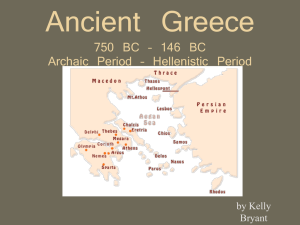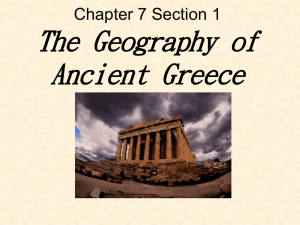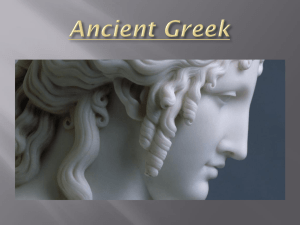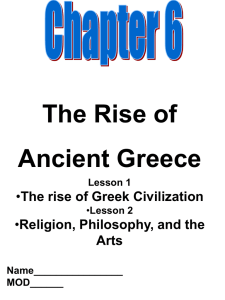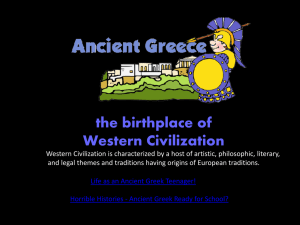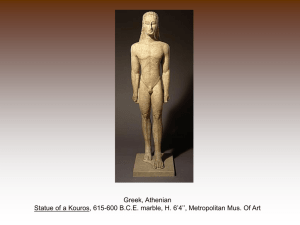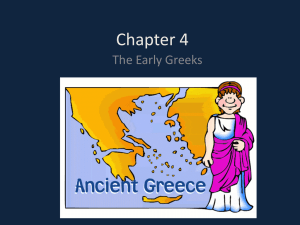Ancient Greece: Civil and Later Greek Architecture
advertisement
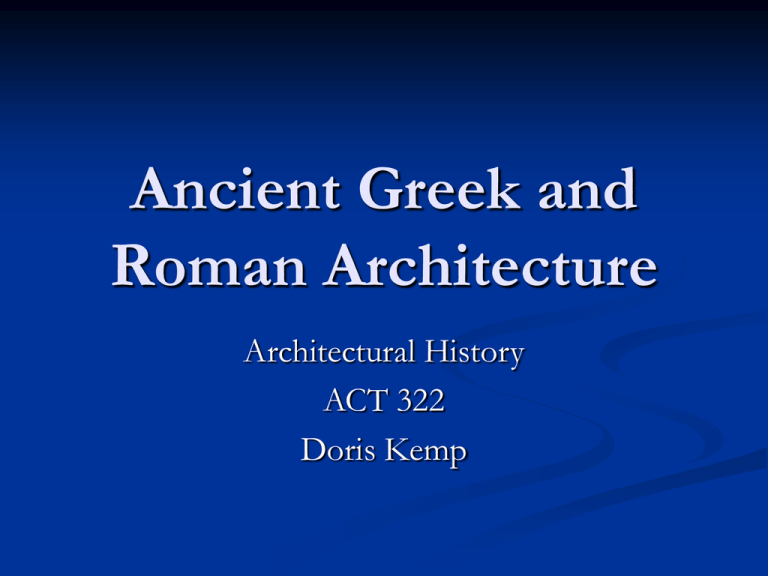
Ancient Greek and Roman Architecture Architectural History ACT 322 Doris Kemp Topics Acropolis Corinthian Order Corinthian Order Architecture Later Greek Architecture Civic Architecture City Planning Ancient Greece: Acropolis Athenian Acropolis Located in modern day Athens Means “City on the height” Destroyed in 480 B.C. and rebuilt in 450 B.C. under the democratic statesman, Pericles Photo: Sullivan Ancient Greece: Acropolis Athenian Acropolis Site planning was very important Every structure was built with the others in mind The goal was to create a larger single complex consisting of multiple structures The human participants in Greek architecture were of utmost importance Acropolis was designed to control the movements of people from one location to another Grand avenues provided fluent movement through the complex Ancient Greece: Acropolis Photo: Sullivan Ancient Greece: Corinthian Order Corinthian Order The third major Classical Greek order Has been seen as an independent order since the time of the Roman historian, Vitruvius Features Actually considered a variant of the Ionic Order by many modern architectural historians Richness of ornamentation and more freedom of expression by designers Alexander the Great Had enormous influence on this style after he united Greece and built many new cities Ancient Greece: Corinthian Architecture Temple of Athena Alea Located at Tegea Considered an ideal Corinthian structure Photo: Sullivan Ancient Greece: Corinthian Architecture Bassae The only Corinthian structure still standing Photo: Sullivan Ancient Greece: Corinthian Architecture Tholos Means round temple The two most important tholos appear at Delphi and Epidaurus Photo: Sullivan Ancient Greece: Corinthian Architecture Temple of Zeus Olympius Located in Athens c. 170 B.C. The first structure that bore a Corinthian reflection in mainstream society Dwarfed the Parthenon Photo: Sullivan Ancient Greece: Later Greek Architecture Hellenistic Greece began after the death of Alexander the Great in 323 B.C. Several important structures were built during this time Temple of Apollo at Didyma Mausoleum at Halicarnassus Altar of Zeus at Pergamum Sanctuary of Asclepius Ancient Greece: Later Greek Architecture Temple of Apollo at Didyma c. 300 B.C. Actually completed by the Romans Considered one of the most imaginative Greek shrines Photo: Sullivan Ancient Greece: Later Greek Architecture Mausoleum at Halicarnassus One of the Seven Wonders of the Ancient World Built for the King Mausolus by his wife Featured a pyramid-like roof that many scholars believe was influenced by the pyramids of Egypt Photo: Sullivan Ancient Greece: Later Greek Architecture Photo: Sullivan Ancient Greece: Later Greek Architecture Altar of Zeus at Pergamon Featured an Ionic like theme Has been partly reconstructed in the State Museum, Berlin, Germany Features a mural along its base depicting a battle of the Gods and the Titans Photo: Sullivan Ancient Greece: Later Greek Architecture Sanctuary of Asclepius on the Island of Kos Tribute to the god of medicine Sickly people came to be healed by the waters of a natural spring located within the structure Had a much grander scale than the Altar of Zeus Documented a profound change in Greek architecture from past structures Ancient Greece: Later Greek Architecture Photo: Sullivan Ancient Greece: Civic Architecture Agora Located in Athens near the Acropolis An ancient “mall” Combination marketplace and civic center Key structures Stoa of Zeus One of Socrates favorite meeting places Stoa of Attalus II Grandest stoa in the Agora Believed to have housed one of the three branches of Greek government Ancient Greece: Civic Architecture Photo: Sullivan Ancient Greece: Civic Architecture Photo: Sullivan Ancient Greece: Civic Architecture Theatre at Epidaurus The most famous Greek theatre Recognized for its amazing acoustics A pin dropped at the center of the theatre can be heard in the farthest seats Set against a beautiful Greek landscape Photo: Sullivan Ancient Greece: Civic Architecture Photo: Sullivan Ancient Greece: Civic Architecture Stadiums Most famous are located in Olympia and Athens Used for athletic events A key part of Greek life Served as the locations for the Greek Olympics Photo: www.ancient-greece.org Ancient Greece: City Planning Greek architecture was mostly focused on public buildings They were not as concerned with the afterlife and private palaces such as the Egyptians City planning was based upon the inhabitants and the terrain Ancient Greece: City Planning Hippodamus Famous Greek intellectual who devised a five step plan to city planning Five step plan City was cut by several main streets crossing at right angles The resulting rectangles were subdivided into blocks The blocks were further subdivided into house plots Public buildings were placed accordingly to avoid congestion The plan of the city was based on the particular terrain Ancient Greece: City Planning Examples of planned Greek cities Miletus The first planned Greek city Priene Prominent Hippodamian scheme Constructed on a hillside Prime example of a Greek urban scheme Ancient Greece: City Planning Photo: Sullivan Ancient Greece: City Planning Photo: Sullivan References Sullivan, Mary; http://www.bluffton.edu/~sullivanm/ http://www.brynmawr.edu/Acads/Cities/wld/wdpt1.html Trachtenburg/Hyman; Architecture: From Prehistory to Postmodernity Wodehouse/Moffett; A History of Western Architecture Ancient Greek and Roman Architecture Architectural History ACT 322 Doris Kemp

